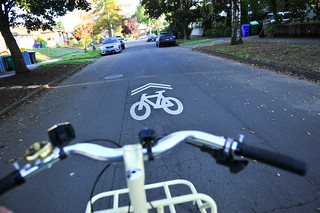The article below was sent to BikePortland via email by reader Lisa M. I didn’t ask her to submit the piece it was just there in my inbox one morning a few days ago. I’ve chosen to share her story here on the Front Page because I think she captures some important issues and emotions that I and others share (not to mention it’s well written).
During my commute home from work yesterday, a day that had turned beautifully sunny and clear after a sporadic spring hailing, I was involved in a car accident.
I was struck when the other driver ran a clearly visible stop sign, proceeding directly into me. Good Samaritans stopped to make sure I was OK, the police were called and an ambulance and fire truck soon followed. A witness from a nearby home brought me an ice pack while I sat on the edge of the sidewalk, crying. I wondered how badly I was injured, how I would pay for the damages and medical bills, and how to recoup the money I would inevitably lose due to time away from work. The driver, a teenager, apologized and cried while sitting next to me, clinging to the paperwork she had planned to drop off at school. All in all, it was a sad but typical car accident experience.
“What has been done to protect our health and safety? A sharrow here or there, bike lanes that end randomly and traverse road debris and metal sewer grates, a few bike lights and yield signs… nothing of substance.”
Only it wasn’t typical: I was riding my bike.
I was riding on a low-traffic, designated bike route when the car t-boned my back wheel. I was lucky; I ploughed into the ground at high speed, my hip and head forcefully crashing onto and then dragging along the pavement. Had the driver hit me any further forward on my bike, I would have been run over. I’m left with a bulging disc in my spine, a sprained neck, back, hip, and wrist, and the sinking sensation that commuting by bicycle in my city is not safe.
Indeed, I was lucky. Others, like Hank Bersani, have not been. And what is our government doing to prevent these tragedies? What has been done to protect our health and safety? A sharrow here or there, bike lanes that end randomly and traverse road debris and metal sewer grates, a few bike lights and yield signs… nothing of substance. Nothing that actually treats people, not vehicles, as a vested interest.
Our government may have limited resources, but our poorly implemented and thought out bike infrastructure is a problem of priority, not expense.
Bike infrastructure costs less to build and less to maintain than car infrastructure. There is a reduction in healthcare costs associated with regular cycling, and a recently reported study showed an equivalent $0.42 economic gain for every mile biked compared to a $0.20 economic loss for every mile driven. Supporting and encouraging citizens to bike is an investment that pays off, all while leaving extra funds for education and other basic services.
And even in these tight times, the funding is there. We just choose to do nothing. We choose to treat the loss of Hank Bersani, the devastation of his family and friends, and preventing the torment of the next family who will receive a similar solemn phone call as a “waste” of taxpayer resources.
Bicycle infrastructure has and continues to be treated as a frivolous expenditure. The reality is: bike infrastructure is necessary for the basic safety of our citizens. It saves lives.
All I could think about in the ambulance ride was that no one should ever have to experience this. No one should fear for their life just because they ride a bike. Something needs to change and it needs to change now.
I just returned from a trip to Europe where I rode bikes in Paris, Munich, and parts of Austria. The biggest difference there versus here? Cyclists mattered. Pedestrians mattered. They were not “less than” a car, they were prioritized.
Separated bike lanes, bike lights, concrete barriers on busier roads all removed the issue of safety from my mind. Instead I could just focus on the joy of cycling while experiencing often-lost interaction with other community members while we rode the paths together.
This can happen here, but only if we make it happen.
Our safety and the safety of our neighbors is a priority right now, not in 30 years time.
How many more families have to lose a father, son, mother, daughter, sister, brother, cousin, grandparent, husband, wife, partner, friend before we take this seriously?
—
Thanks for sharing your story Lisa. Hope you heal up well and soon.


